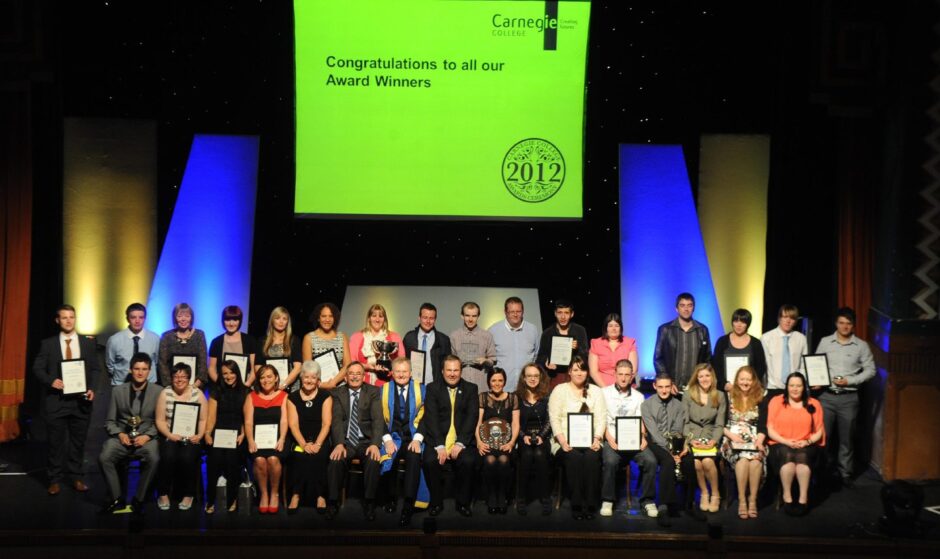
Fife College has its roots in Lauder Technical School, which “rose like Aladdin’s Palace” and opened 125 years ago in Dunfermline.
The name, Lauder, was that of Andrew Carnegie’s uncle, George, after whom the Dunfermline millionaire and philanthropist insisted the college be named.
Lauder took a great interest in education in Dunfermline.
Opening a technical school was his dream.
Carnegie was a self-made steel tycoon and he gave his nephew £10,000 to build the “endowed centre of craft training for local apprentices”.
He gave all the credit to Lauder at the opening ceremony on October 10 1899.
“I had simply to write a few words on a sheet of paper – and this school rose like Aladdin’s Palace,” said Carnegie.
“I only had to rub the ring.
“To my uncle belongs the credit.
“He bore aloft the lamp.
“He devoted years of his time and of his thought to the subject and I but a minute.
“It is not he who gives money that he never misses who is the real giver, but the man who gives his heart to the work – and that my uncle did.”
What did Andrew Carnegie ask for?
Carnegie moved Lauder to tears with a wish “lying very near to my heart”.
“It is not a new wish,” he said.
“It was born the day that I begged uncle to take £10,000 to build this school.
“I ask nothing in regard to this school.
“But it would give me and Mrs Carnegie genuine pleasure if you would approve of calling this the Lauder Technical School, so that the man who is really the spirit which produced this school may have his name go down in your annals forever as a citizen who, in his day and generation, has done the town some service.”
Lauder was overcome by emotion.
His speech was read out by manufacturer William Robertson.
He said: “When I found myself at the age of 25 at the back of a counter, with a deficient education for the trade I had got engaged in, I resolved that every youth that came under my influence would get a good technical and literary training.
“I could mention many individuals who I have assisted in this way but two of them were my son George Lauder and my nephew Andrew Carnegie.
“I say that Mr Carnegie and myself are entitled to express some wish on the subject.
“In short, I ask our good town frankly, if we have done this for Dunfermline, what is Dunfermline going to do for itself?”
What course would you have taken?
Of particular interest were coal mining courses designed over a three-year basis.
Virtually everyone in the area was related to someone who worked in the pits at some time or another and the roll call of collieries reads like a map of Fife.
The school’s surroundings in Priory Lane kept pace with progress.
An extension with red sandstone was added in 1910 to house the textile department that taught weaving following a £3,300 contribution from Carnegie.
Carnegie died aged 83 on August 11 1919 at Lenox, Massachusetts.
By the end of his life it was calculated that he had given away over $350 million.
Generations of students in Dunfermline benefited from the generosity of Carnegie.
Lauder College subsumed the Cowdenbeath Mining School in 1926, which was of similar antiquity and the accident rate in the mines was cut by half through education.
In August 1936 students created a record for the number of exam passes.
Courses included carpentry and joinery, electrical engineering, linen weaving, machine design, motor vehicle engineering, painting and decorating, and plumbing.
Breadmaking and flour confectionary were among the others.
Lessons were given on gas warfare during the Second World War and school life generally went on as it had before, although certain men were called up.
The first of many name changes in 1951
The Further Education Sub-Committee approved a name change in November 1951.
The four technical schools in Fife would be known as colleges.
Head teachers became principals.
Evening classes were a massive success, including china painting in 1952.
Students were taught the craft by housewife Mary Hutchison from Elgin Street.
Lauder and Cowdenbeath Technical College merged in 1967.
Numbers grew steadily in further education to 28,000 across Fife in 1969.
Change was on the horizon.
Lauder Technical College moved to a new campus in Halbeath Road in 1970.
Part of the former building was retained and incorporated into housing on the site.
The courses offered, and the general direction of the college, began moving away from its origins in the mining and textile industries as these all but vanished.
John Lisgo became principal at the relatively young age of 43 in 1983.
In 1986 there were courses in business studies, catering, computer studies, electronic engineering, motor vehicle engineering, technician studies and welding.
Hotel reception, health studies and junior hotel management were also available.
Lauder College was recognised internationally
Lauder Technical College became Lauder College in 1989.
Little changed.
The 1990s brought more academic success.
There were four national firsts in Scottish Vocational Qualifications (SVQs) and a flattering report from Her Majesty’s Inspectors of Schools.
The report found Lauder College presented an attractive and motivating environment that promised a professional approach to its work.
The Duke of Edinburgh visited in 1992 and opened the Dunfermline Conference Centre in the college, which was refurbished to international standards.
He also saw the Project 2000 House of Tomorrow development that was designed and built on campus by students and which gave a glimpse of the future.
The college’s certification of British Standard 5750 in 1993 for its entire educational programme was a crowning achievement and recognised internationally.
More than 5,500 students were provided with education and training in 1993.
Lauder College became Carnegie College in 2007.
And then more change.
Fife College celebrates Carnegie’s legacy
The Adam Smith and Carnegie colleges merged to form Fife College in August 2013.
The first principal was Hugh Logan, who predicted the new college would have a fundamental and positive effect on people’s lives and futures.
He was right.
Looking to the future, it’s also never forgotten its past.
A Carnegie Day took place on what would have been Andrew Carnegie’s birthday.
The man who gave his name to Lauder College is remembered with the George Lauder Bursary, while the annual Lauder Lecture gives a platform to thought leaders.
Jim Metcalfe, Fife College principal, said: “Fife College exists to help students, staff, and communities thrive by providing opportunities for all, delivering outstanding education, and driving economic prosperity throughout the region.
“Our 125th anniversary is a historic event for Fife.
“A moment to reflect on the college’s enduring commitment to outstanding technical education, to innovation, and to our community.
“It is a time for us to honour the remarkable legacy of those who laid the foundations for our success generations ago.
“But this milestone is not just a celebration of our past achievement.
“It is also an opportunity for us to share our ambitions for the future.”
Current and former students and staff are being asked to honour the past by sharing their own memories of life on campus to celebrate the 125th anniversary.
Their stories are all part of a rich history that started with one man’s dream.
• People can visit Fife College’s social media pages or email alumni@fife.ac.uk





















Conversation